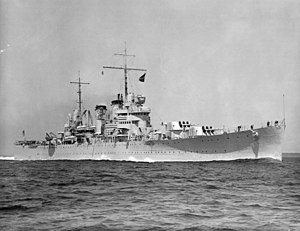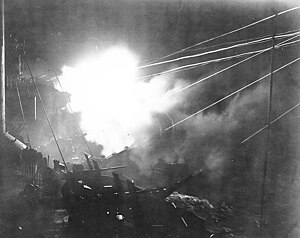| USS Boise (CL-47) | |
|---|---|
 USS Boise at sea, 1938 | |
| Career | |
| Laid down: | 1 April 1935 |
| Launched: | 3 December 1936 |
| Commissioned: | 12 August 1938 |
| Decommissioned: | 1 July 1946 |
| Fate: |
Sold to Argentina, 11 January 1951 Decommissioned and scrapped 1978 |
| General characteristics | |
| Displacement: | 9,700 tons |
| Length: | 608 ft 4 in (185.42 m) |
| Beam: | 61 ft 9 in (18.82 m) |
| Draft: | 24 ft (7.3 m) |
| Speed: | 33.5 kn (38.6 mph; 62.0 km/h) |
| Complement: | 868 officers and enlisted |
| Armament: | 15 × 6 in (150 mm)/47 cal guns, 8 × 5 in (130 mm)/25 cal guns[1] |
USS Boise (CL-47) was a United States Navy Brooklyn-class light cruiser. The cruiser was named for Boise, the capital city of the state of Idaho.
Boise was launched on 3 December 1936 by Newport News Shipbuilding and Dry Dock Company, Newport News, Virginia, sponsored by Miss Salome Clark, daughter of Governor Clark of Idaho; and commissioned on 12 August 1938, Captain Benjamin Vaughan McCandlish in command.
[]
Inter-war period[]
In February 1939, following a shakedown cruise to Monrovia, Liberia and Cape Town, Union of South Africa, Boise joined Cruiser Division 9 (CruDiv 9), Battle Force, at San Pedro, California. Until November 1941, she operated alternately off the west coast and in Hawaiian waters. She then escorted a convoy to Manila, Philippine Islands, arriving on 4 December.
World War II[]
The outbreak of war in the Philippines on 8 December 1941 found Boise off Cebu Island. She joined Task Force 5 (TF 5) in the East Indies, but on 21 January 1942 struck an uncharted shoal in Sape Strait and had to retire to Colombo, Ceylon; Bombay, India; and Mare Island Navy Yard for repairs. Her repairs completed, she sailed on 22 June to escort a convoy to Auckland, New Zealand.
Boise returned to Pearl Harbor and was tasked to conduct a raiding cruise in Japanese waters in hopes of creating an impression, including generating radio traffic, of a striking force heading for Japan to draw attention away from preparations for Guadalcanal. Boise departed Pearl Harbor 27 July and was expected to begin this raid on the Japanese sampan patrol line guarding approaches to Honshu about 750 miles east of Tokyo on 5 August. She completed the raid on 8 August. Two seaplanes that had to land on the water at sunset were lost, one being found by the Japanese with indications this caused apprehension of a strike force preparing to attack Japan.[2][3]
In August, she escorted a convoy to Fiji and New Hebrides. From 14–18 September, she helped cover the landing of Marine reinforcements on Guadalcanal.[4]
On the night of 11—12 October 1942, during the Battle of Cape Esperance, the task force of which Boise was part encountered a force of Japanese cruisers and destroyers to the west of Guadalcanal. In the engagement Boise was hit a number of times, twice by fire from a Japanese heavy cruiser from about 7,500 yards (6,900 m) range. One hit exploded upon impact on her armor causing little damage. The other exploded in the 6" magazine located between number I and II turrets causing a powder fire and flooding, putting turrets I, II, and III out of action and causing a number of casualties.[5]
A total of 107 crew were killed by the fire.[citation needed] Under the command of Captain "Mike" Moran, who was later awarded the Navy Cross for his leadership during the battle,[citation needed] Boise made her way to Philadelphia Navy Yard, where she underwent repairs from 19 November 1942 to 20 March 1943.[4] The gunfire damage was the first case available for complete Bureau of Ships analysis.[5]

"Pick Out the Biggest One and Fire!" – wartime propaganda poster quoting a command issued by Captain Edward J. "Mike" Moran on the USS Boise, during a battle near the Solomons
Boise departed on 8 June for the Mediterranean, arriving at Algiers, Algeria on 21 June. From 10 July to 18 August, she acted as a cover and fire support ship for the Amphibious Battle of Gela during the Invasion of Sicily. In September, she took part in the Italian mainland landings at Taranto (9–10 September) and Salerno (12–19 September). She returned to New York on 15 November, and once again steamed to the South Pacific, arriving at Milne Bay, New Guinea on 31 December.

Boise firing on positions in New Guinea
During January–September 1944, she took part in operations along the northern shore of New Guinea, including: Madang-Alexishafen bombardment (25–26 January); Humboldt Bay landings (22 April); Wakde-Sawar bombardment (29–30 April); Wakde-Toem landings (15–25 May); Biak landings (25 May – 10 June); Noemfoor landings (1–2 July); Cape Sansapor landings (27 July – 31 August); and the occupation of Morotai (1–30 September). The cruiser then moved north, as the battle front advanced into the Philippines, taking part in: Leyte invasion (20–24 October); Battle of Surigao Strait (25 October); Mindoro landings (12–17 December); Leyte-Mindoro covering action (26–29 December); Lingayen Gulf landings, with General Douglas MacArthur embarked (9–13 January 1945); Luzon covering force (14–31 January); Bataan-Corregidor occupation (13–17 February); and Zamboanga landings (8–12 March). She then moved to Borneo for the Tarakan landings (27 April – 3 May).
From 3–16 June, she carried General MacArthur on a 3,500 mi (5,600 km) tour of the Central and Southern Philippines and Brunei Bay, Borneo, and then returned to San Pedro, California, arriving on 7 July. There she remained, undergoing overhaul and training until October. She sailed on 3 October for the east coast, arriving at New York on 20 October. Boise remained there until decommissioned on 1 July 1946.
[]
Boise was sold to Argentina on 11 January 1951, along with Phoenix, where they were commissioned as the Nueve de Julio ("9 July", Argentina's Independence Day) and Diecisiete de Octubre (later renamed General Belgrano ) respectively.
During her years as an Argentinian warship, she took part of the so-called Revolución Libertadora, shelling oil depots and military facilities around the coastal city of Mar del Plata, on 19 September 1955. She was accidentally rammed by ARA General Belgrano on exercises in 1956, which resulted in damage to both cruisers.[6]
Nueve de Julio remained in service with the Argentine Navy until 1978, when she was decommissioned and towed to Japan for scrapping.[7]
Awards[]
Boise received 11 battle stars for her service in World War II.
Notes[]
- ↑ Fahey 1941 p. 9
- ↑ Nimitz 1942, pp. 625, 816, 821-822, 825.
- ↑ Cressman 1999, p. entry for July 27, Mon..
- ↑ Historia de los Cruceros Argentinos (Spanish)
- ↑ Bonner, p.41
References[]
- Bonner, Kermit (1996). Final Voyages. Turner Publishing Company. ISBN 1-56311-289-2.
- Cressman, Robert J. (1999). "The Official Chronology of the U.S. Navy in World War II". Contemporary History Branch, Naval Historical Center (now Naval History & Heritage Command). http://www.ibiblio.org/hyperwar/USN/USN-Chron/index.html. Retrieved 27 May 2013.
- Fahey, James C. (1941). The Ships and Aircraft of the U.S. Fleet, Two-Ocean Fleet Edition. Ships and Aircraft.
- Naval History And Heritage Command. "Boise". Dictionary of American Naval Fighting Ships. Naval History And Heritage Command. http://www.history.navy.mil/danfs/b7/boise-i.htm. Retrieved 21 September 2013.
- Navy Department, Bureau of Ships (25 January 1943). "U. S. S. Boise (CL47)—Gunfire Damage—Savo Island 11-12 October, 1942 (War Damage Report No. 24)". War Damage Reports. Navy Department (Digital copy hosted by HyperWar). http://ibiblio.org/hyperwar/USN/WarDamageReports/WarDamageReportCL47/WarDamageReportCL47.html. Retrieved 21 September 2013.
- Nimitz, Chester W., Admiral (USN); Steele, James M., Captain (USN) (1942). ‘Gray Book’ — War Plans and Files of the Commander-in-Chief, Pacific Fleet; Running Estimate and Summary maintained by Captain James M. Steele, USN, CINCPAC staff at Pearl Harbor, Hawaii, covering the period 7 December 1941–31 August 1942.. 1 of 8 volumes. Operational Archives, Naval History and Heritage Command, Washington Navy Yard, Washington D.C.. http://www.ibiblio.org/anrs/docs/D/D7/nimitz_graybook1.pdf.
- This article incorporates text from the public domain Dictionary of American Naval Fighting Ships. The entry can be found here.
Further reading[]
- Morris, Frank Daniel (1943). "Pick out the biggest": Mike Moran and the men of the Boise. Houghton Mifflin Co.
External links[]
| Wikimedia Commons has media related to USS Boise (CL-47). |
The original article can be found at USS Boise (CL-47) and the edit history here.